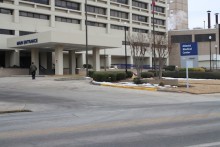
Despite uncertain government funding, two metro Atlanta hospitals are poised to expand the area’s trauma network.
State regulators are expected to visit the Atlanta Medical Center this month to determine whether it should be elevated to a Level 1 trauma center, the kind that handles the most serious cases. The downtown hospital has operated a Level 2 trauma service for years. If it is upgraded to a Level 1, that could reduce the load on nearby Grady Memorial Hospital, which operates the only Level 1 center in metro Atlanta.
Meanwhile, WellStar Kennestone Hospital in Marietta has announced plans to open a Level 2 trauma center later this year. If the plans are approved by the state, Kennestone will become the only trauma center in the heavily populated northwestern quadrant of metro Atlanta. This would be a return for the hospital to the state’s trauma network, which it dropped out of in 2001 because of escalating costs of uncompensated care.
The developments come even though Georgia voters rejected a November referendum that would have imposed a $10 annual fee on vehicle license tags to help pay for trauma care. Trauma experts have concluded that on average 700 lives per year are lost in Georgia because of the lack of accessible trauma care services. A survey of the 17 hospitals within the trauma network in 2007 showed that the combined operating loss on trauma services exceeded $70 million.
The Georgia General Assembly responded with a one-time appropriation of $59 million in 2008 to stabilize the network and keep hospitals and physicians from dropping out. More than $38 million of it went to offset the costs of providing trauma services for patients who could not pay their bills.
Since then, the only funds the state appropriates specifically for trauma care come from proceeds acquired through the 2009 “super speeder” law, which sets a $200 fine for motorists who are caught doing 85 miles per hour or more on interstate highways or 75 mph or more on two-lane roads. That law was expected to generate about $23 million annually, but it has not lived up to those revenue expectations, according to Jim Pettyjohn, executive director of the Georgia Trauma Commission.
Even without the certainty of funding, the Atlanta Medical Center and Kennestone developments are “great news for the communities these hospitals serve,” Pettyjohn said. “It says they are responsible and want to help in building a trauma system for the state.”
Easing the pressure on emergency providers
Officials for both hospitals declined to be interviewed for this story, other than to confirm the institutions’ plans. Both are routinely handling trauma cases – in the Atlanta Medical Center’s case, the Level 2 center already takes in severe trauma cases when Grady is overloaded. Upgrading its status would allow AMC to receive a somewhat higher level of reimbursement from the state for the uncompensated care it provides and potentially take more of the load off Grady’s shoulders.
Kennestone operates one of the busiest emergency rooms in the state and handles more than 1,300 trauma patients per year, treating them in house or stabilizing them to go to a network trauma facility. The hospital now has three emergency trauma rooms, but it will need to have a designated team of physicians who will concentrate on trauma care before it can be approved for the network. (It recently recruited a trauma specialist from Gwinnett Medical Center to head up the team.)
The Marietta hospital started researching what it would take to rejoin the trauma network more than a year ago, and applied for a grant from the state trauma commission that could offset some planning costs. By becoming part of the network, it may eventually be able to recoup some of its expense for providing trauma care to uninsured or underinsured patients.
Pettyjohn said six other hospitals statewide have applied to the trauma commission for startup grants to establish trauma centers. They are Athens Regional Medical Center; Taylor Regional Hospital, Hawkinsville; Emanuel Medical Center, Swainsboro; Lower Oconee Community Hospital, Glenwood; Walton Regional Medical Center, Loganville; and Wells Memorial Hospital, Washington.
State committed to improvement
The “super speeder” law also provides an increased fee for drivers who renew their licenses after they have been suspended. As more counties get better at collecting the fines, Pettyjohn said, funding for the commission could become more stable, and more hospitals could seek startup grants.
Uncertainty about revenue was one of the reasons trauma advocates pressed for a permanent funding source, like the one proposed – and rejected – by voters in November. Had the license-tag fee been approved, it would have raised the $80 million that the trauma commission estimates will be required annually to sustain a full trauma system. Because the trauma commission is an arm of state government, it was not allowed to campaign for the referendum, known as Amendment 2. (The amendment was defeated by about 100,000 votes out of a total of 2.5 million cast.)
“It’s important to remember that 1.2 million Georgians voted yes on Amendment 2,” Pettyjohn said. “They saw fit to vote to tax themselves so that the state would have an adequately funded trauma system. And many of those who voted against the amendment still support establishing a better system. They may have felt the Legislature should fund it with other resources.”
“The state has a plan to build the system” by working with hospitals like Atlanta Medical Center and Kennestone, Pettyjohn said. “We will get there.”

